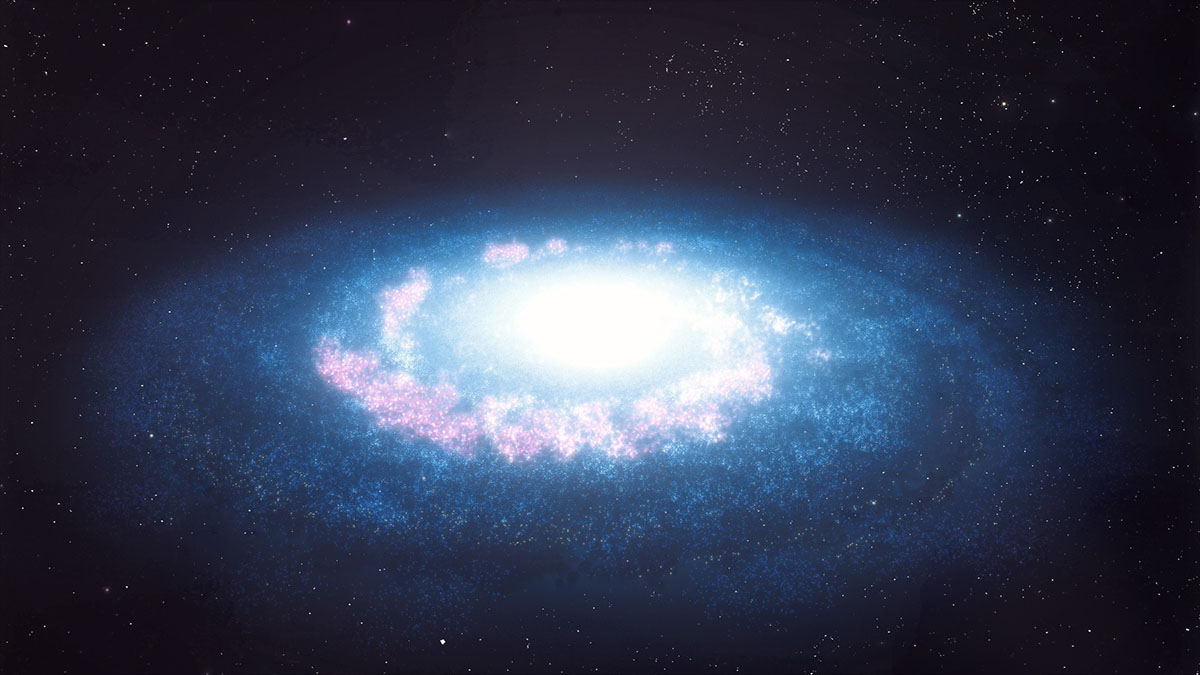peeking at dark matter during a tidal strip show

Dark matter is a substance that makes up nearly all mass in the universe, but decades after we discovered it, all we have are indirect measurements which show us that it’s there in very large amounts, forming galactic halos, but ultimately, little else. It doesn’t seem to interact with any of the stuff that makes stars, dust, and planets, it emits or reflects no radiation, and this utter lack of interesting properties we could study leads to much wailing and gnashing of teeth on physics blogs and forums, wondering if it even exists. But there might finally be a glimmer of light in the study of dark matter because there’s now evidence that it can interact with itself and matches at least one theoretical behavior. While that doesn’t sound like much, it’s actually a pretty big deal because it narrows down the possible culprits and shows that we can design some way to catch particles exhibiting this behavior to figure out this mystery once and for all. Hopefully.
Last year, a team of researchers was examining the Bullet Cluster, which is actually two galaxy clusters undergoing a series of violent collisions, to try and detect dark matter interactions and figure out to what, if anything other than gravity, dark matter responds. The observations were not exactly conclusive, but they didn’t completely rule out dark matter particles colliding, just set a bound in which they can be expected to collide. Armed with this data, the same team tried to catch a glimpse of interacting dark matter particles in a cluster of just four galaxies, Abell 3827, hoping to get more detail how their galactic halos behave during tidal stripping events. Despite sounding like something like something one galaxy does for another to keep things interesting and relieve a little stress, it’s actually when galaxies shed stars, gas, dust, and dark matter to larger galaxies which exert powerful tidal forces on them across millions of light years.
Now, during tidal stripping, there’s a lag between matter being absorbed into a new galaxy and more matter coming in from the old galaxy because as clouds of dust and gas collide, they heat up, producing radiation, and create drag that pushes incoming material back. One inconclusive observation says it may have detected odd gamma ray flares that could be dark matter colliding during this phenomenon, but since no others have, some cosmologists concluded that it means that dark matter doesn’t interact with itself. But the team observing Abell 3827 found the tell tale signs of a significant lag in dark matter halos with a rate of interaction which fell neatly into their previous results. This means that dark matter particles are colliding, creating shockwaves and a detectable lag between absorbed and incoming clouds. In fact this lag can be up to 5,000 light years which isn’t much on a galactic scale, but definitely big enough that it’s unlikely to be just a fluke, or a random artifact in the data. Finally, we know something new about dark matter!
Of course, we still don’t know what it really is, but we can now rule out a whole host of extremely exotic candidates which can’t interact with each other, and start designing detectors to seek out even more such events to confirm the observation and gather more data. With each new piece of information we tease out, we can eliminate more and more culprits until can actually design a way to capture dark matter itself. It may take decades more until we get to that point, but like a punishing, extremely difficult game can give you immense satisfaction when you finally manage to figure out the rules and advance, so can a profound and difficult to solve mystery like finding out what dark matter really is. Maybe it will be nothing groundbreaking in the end, and maybe it won’t change anything we think we know about the universe, but just the fact that we persisted, observed, experimented, theorized, and then observed some more to figure it out should make us a little more proud of our species in general for not giving up on a very difficult question.
See: Harvey, D., et al (2015). The nongravitational interactions of dark matter in colliding galaxy clusters Science, 347 (6229), 1462–1465 DOI: 10.1126/science.1261381
Massey, R., et al. (2015). The behavior of dark matter associated with bright cluster galaxies in the core of Abell 3827 MNRA, 449 (4), 3393–3406 DOI: 10.1093/mnras/stv467





